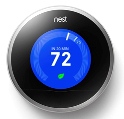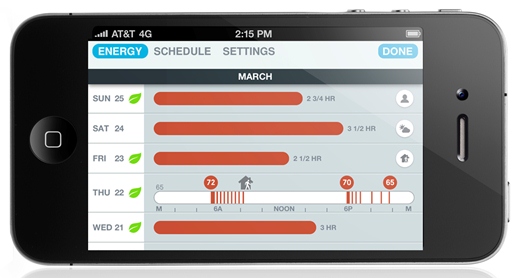While Nest is focused on the residential and light commercial space, it is not unreasonable to expect to see similar technologies in future commercial products.
Paul Ehrlich, Ira
Goldschmidt
& Angela Lewis
Building
Intelligence Group
|
January 2013 |
[an error occurred while processing this directive] |
|
How
Home Automation may transform Building Automation
While Nest is focused on the residential and light commercial space, it is not unreasonable to expect to see similar technologies in future commercial products. |
Paul Ehrlich, Ira
Goldschmidt
& Angela Lewis January
Issue -
Column
|
| Articles |
| Interviews |
| Releases |
| New Products |
| Reviews |
| [an error occurred while processing this directive] |
| Editorial |
| Events |
| Sponsors |
| Site Search |
| Newsletters |
| [an error occurred while processing this directive] |
| Archives |
| Past Issues |
| Home |
| Editors |
| eDucation |
| [an error occurred while processing this directive] |
| Training |
| Links |
| Software |
| Subscribe |
| [an error occurred while processing this directive] |
The greatest risk and
potentially greatest benefit to any industry is
disruptive technology. There are many examples of this such as
the impact of e-mail on the sales of fax machines and on the postal
service, or of music downloads on the sales of CD’s, cassette tapes and
record albums. Disruptive technologies often provide improved
performance and lower costs, largely obsoleting older and more mature
technologies.
Building Automation is an example of a disruptive technology, largely
making older electronic and pneumatic controls largely obsolete and
providing better control and management at the same or lower
costs. So what is the next disruption coming in this area?
There are several areas that we have been tracking, including the use
of low cost network technologies and influence from consumer
technologies including home and automotive automation. We have
seen the use of network technologies become fairly common in BAS
systems, as most systems use web browsers and network communications as
standard. However Internet enabled thermostats and light
switches are not yet readily available.
The broad advent of low cost, high performance, home automation
systems has always been one of the largest risks to the commercial
building automation market. After all, if you can have an
inexpensive home system, moving it into the light commercial space is
fairly easy and moving into larger buildings is not an enormous
stretch. Unfortunately home automation has been slow to evolve,
in fact I was at a conference on home automaton years ago and heard the
quote “it is the next big thing and has been for the last seven
years.” Now it appears that this may all be changing due to the
introduction of a new product from a Silicon Valley startup called Nest
Labs.
 An Apple alumni
involved with the design of the IPOD started Nest Labs,
and this is evident in the attention to design of their first product
the Nest Thermostat. This simple looking thermostat offers a
clean user interface and remote control through a web browser or smart
phone application. I was recently talking to a client about
updating their building automation system, only to have him pull out
his phone and explain how the new system needed to work like his Nest
Thermostat at home. He went on to explain how you can readily change
setpoints, schedules, and even view usage from anywhere.
An Apple alumni
involved with the design of the IPOD started Nest Labs,
and this is evident in the attention to design of their first product
the Nest Thermostat. This simple looking thermostat offers a
clean user interface and remote control through a web browser or smart
phone application. I was recently talking to a client about
updating their building automation system, only to have him pull out
his phone and explain how the new system needed to work like his Nest
Thermostat at home. He went on to explain how you can readily change
setpoints, schedules, and even view usage from anywhere.

[an error occurred while processing this directive]Recently I installed one of these devices in my home
office and I
realize that this may very well be the genesis of the next disruptive
technology for commercial building automation. It is a relatively
inexpensive product, with great user interface, and built in wireless
networking. Not surprisingly the new product from Nest
(Generation II) works with multi-stage units and could readily be
applied to light commercial projects. While Nest is focused on
the residential and light commercial space, it is not unreasonable to
expect to see similar technologies in future commercial products.
Perhaps the age of Internet enabled thermostats is not all that far out
after all!
About
the Authors
 Paul
and Ira first worked together on a series of ASHRAE
projects including the BACnet committee and Guideline 13 – Specifying
DDC Controls. The formation of Building Intelligence Group provided
them the ability to work together professionally providing assistance
to owners with the planning, design and development of Intelligent
Building Systems. Building Intelligence Group provides services for
clients worldwide including leading Universities, Corporations, and
Developers. More information can be found at www.buildingintelligencegroup.com
We also invite you to contact us directly at
Paul@buildingintelligencegroup.com or
ira@buildingintelligencegroup.com
Paul
and Ira first worked together on a series of ASHRAE
projects including the BACnet committee and Guideline 13 – Specifying
DDC Controls. The formation of Building Intelligence Group provided
them the ability to work together professionally providing assistance
to owners with the planning, design and development of Intelligent
Building Systems. Building Intelligence Group provides services for
clients worldwide including leading Universities, Corporations, and
Developers. More information can be found at www.buildingintelligencegroup.com
We also invite you to contact us directly at
Paul@buildingintelligencegroup.com or
ira@buildingintelligencegroup.com
[an error occurred while processing this directive]
[Click Banner To Learn More]
[Home Page] [The Automator] [About] [Subscribe ] [Contact Us]